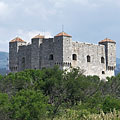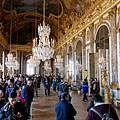(Optimerad för liten skärm enheter)
City Park ("Városliget"), Budapest Zoo: architecture, listed buildings - Budapest, Ungern
Efter att ha klickat:
Klicka på bilderna!
-
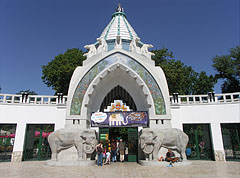
The arched Art Nouveau (secession) style main entrance building
The gate was designed by Kornél Neuschloss and built in 1912, and the current decorative stone pavement around it was created exactly hundred years later, in 2012.
Datum för fotografi: 2013-07-022013
Skapat av: Robert Németh
Kameramodell: Konica Minolta Dimage A200
Budapest, Ungern
-
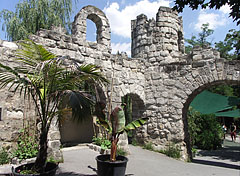
Datum för fotografi: 2013-07-022013
Skapat av: Robert Németh
Kameramodell: Konica Minolta Dimage A200
Budapest, Ungern
-
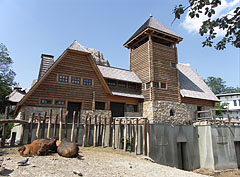
Buffalo House, some African forest buffalos (Syncerus caffer nanus) lying around it
Datum för fotografi: 2013-07-022013
Skapat av: Robert Németh
Kameramodell: Konica Minolta Dimage A200
Budapest, Ungern
-
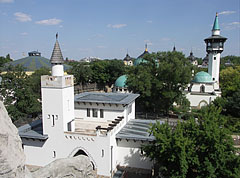
Datum för fotografi: 2013-07-022013
Skapat av: Robert Németh
Kameramodell: Konica Minolta Dimage A200
Budapest, Ungern
-
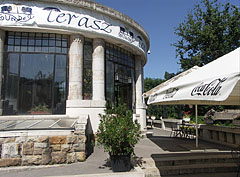
Palm House, Gundel Terrace
Datum för fotografi: 2013-07-022013
Skapat av: Robert Németh
Kameramodell: Konica Minolta Dimage A200
Budapest, Ungern
-
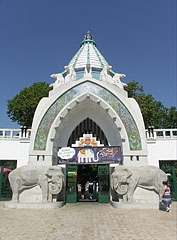
Main Entrance
The artificial cast stone elephant sculptures were made by Gyula Maugsch.
Datum för fotografi: 2013-08-072013
Skapat av: Robert Németh
Kameramodell: Konica Minolta Dimage A200
Budapest, Ungern
-
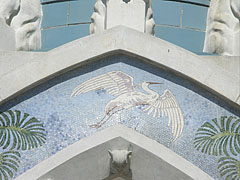
Mosaic picture with a white heron on the gate of the Main Entrance
It was created in the workshop of Miksa Róth in 1912.
Datum för fotografi: 2013-08-072013
Skapat av: Robert Németh
Kameramodell: Konica Minolta Dimage A200
Budapest, Ungern
-

Stone sculpture of a mandrill at the ticket offices
Datum för fotografi: 2013-08-072013
Skapat av: Robert Németh
Kameramodell: Konica Minolta Dimage A200
Budapest, Ungern
-
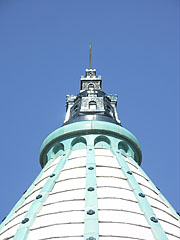
The so-called false dome of the Main Entrance of the Zoo, covered with Zsolnay ceramic tiles
Datum för fotografi: 2013-08-072013
Skapat av: Robert Németh
Kameramodell: Konica Minolta Dimage A200
Budapest, Ungern
-
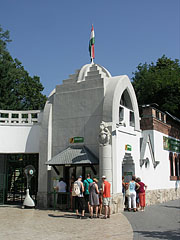
One of the outhouses of the Main Entrance, including a cassa (ticket office)
Datum för fotografi: 2013-08-072013
Skapat av: Robert Németh
Kameramodell: Konica Minolta Dimage A200
Budapest, Ungern
-
The Gundel Confectionery and one of the ticket offices
Datum för fotografi: 2013-08-072013
Skapat av: Robert Németh
Kameramodell: Konica Minolta Dimage A200
Budapest, Ungern
The Gundel Confectionery and one of the ticket offices - Budapest, Ungern -
Gundel Confectionery
Datum för fotografi: 2013-08-072013
Skapat av: Robert Németh
Kameramodell: Konica Minolta Dimage A200
Budapest, Ungern
Gundel Confectionery - Budapest, Ungern -
Terrace of the Gundel Confectionery
Datum för fotografi: 2013-08-072013
Skapat av: Robert Németh
Kameramodell: Konica Minolta Dimage A200
Budapest, Ungern
Terrace of the Gundel Confectionery - Budapest, Ungern -
Main Entrance
Datum för fotografi: 2013-07-022013
Skapat av: Robert Németh
Kameramodell: Konica Minolta Dimage A200
Budapest, Ungern
Main Entrance - Budapest, Ungern -
A gift shop close to the Main Entrance, at the walkway that leads to the Great Lake
Datum för fotografi: 2013-07-022013
Skapat av: Robert Németh
Kameramodell: Konica Minolta Dimage A200
Budapest, Ungern
A gift shop close to the Main Entrance, at the walkway that leads to the Great Lake - Budapest, Ungern -
Bronze sculpture of a pelican, with Braille script description for blind and visually impaired people
The sculpture was created by Katalin Székely in 2005.
Datum för fotografi: 2013-07-022013
Skapat av: Robert Németh
Kameramodell: Konica Minolta Dimage A200
Budapest, Ungern
Bronze sculpture of a pelican, with Braille script description for blind and visually impaired people - Budapest, Ungern -
Interior of the Australia House with stained glass windows
Originally this was the Károly Kós's Bird House, it was built in 1912.
Datum för fotografi: 2013-07-022013
Skapat av: Robert Németh
Kameramodell: Konica Minolta Dimage A200
Budapest, Ungern
Interior of the Australia House with stained glass windows - Budapest, Ungern -
Datum för fotografi: 2013-07-022013
Skapat av: Robert Németh
Kameramodell: Konica Minolta Dimage A200
Budapest, Ungern
- Budapest, Ungern -
Datum för fotografi: 2013-07-022013
Skapat av: Robert Németh
Kameramodell: Konica Minolta Dimage A200
Budapest, Ungern
- Budapest, Ungern -
Datum för fotografi: 2013-07-022013
Skapat av: Robert Németh
Kameramodell: Konica Minolta Dimage A200
Budapest, Ungern
- Budapest, Ungern -
Datum för fotografi: 2013-07-022013
Skapat av: Robert Németh
Kameramodell: Konica Minolta Dimage A200
Budapest, Ungern
- Budapest, Ungern -
Datum för fotografi: 2013-07-022013
Skapat av: Robert Németh
Kameramodell: Konica Minolta Dimage A200
Budapest, Ungern
- Budapest, Ungern -
Datum för fotografi: 2013-07-022013
Skapat av: Robert Németh
Kameramodell: Konica Minolta Dimage A200
Budapest, Ungern
- Budapest, Ungern -
Datum för fotografi: 2013-07-022013
Skapat av: Robert Németh
Kameramodell: Konica Minolta Dimage A200
Budapest, Ungern
- Budapest, Ungern -
János Xántus House
Datum för fotografi: 2013-07-022013
Skapat av: Robert Németh
Kameramodell: Konica Minolta Dimage A200
Budapest, Ungern
János Xántus House - Budapest, Ungern -
Statues of Southeast Asian gods at the János Xántus House
Datum för fotografi: 2013-07-022013
Skapat av: Robert Németh
Kameramodell: Konica Minolta Dimage A200
Budapest, Ungern
Statues of Southeast Asian gods at the János Xántus House - Budapest, Ungern -
Tower of the rebuilt Giraffe House, and a detail of the Buffalo House in the foreground
Datum för fotografi: 2013-07-022013
Skapat av: Robert Németh
Kameramodell: Konica Minolta Dimage A200
Budapest, Ungern
Tower of the rebuilt Giraffe House, and a detail of the Buffalo House in the foreground - Budapest, Ungern -
The covered terrace of the Great Rock ("Magical Hill") with wooden railing
Datum för fotografi: 2013-07-022013
Skapat av: Robert Németh
Kameramodell: Konica Minolta Dimage A200
Budapest, Ungern
The covered terrace of the Great Rock ("Magical Hill") with wooden railing - Budapest, Ungern -
Plastic model of a pteranodon (ancient flying reptile) lookt to the Buffalo House on the Great Rock ("Magical Hill")
Datum för fotografi: 2013-07-022013
Skapat av: Robert Németh
Kameramodell: Konica Minolta Dimage A200
Budapest, Ungern
Plastic model of a pteranodon (ancient flying reptile) lookt to the Buffalo House on the Great Rock ("Magical Hill") - Budapest, Ungern -
Art Nouveau decoration in front of the Elephant House (maybe a lamp post)
Datum för fotografi: 2013-07-022013
Skapat av: Robert Németh
Kameramodell: Konica Minolta Dimage A200
Budapest, Ungern
Art Nouveau decoration in front of the Elephant House (maybe a lamp post) - Budapest, Ungern -
Observation tower on the Elephant House
Datum för fotografi: 2013-07-022013
Skapat av: Robert Németh
Kameramodell: Konica Minolta Dimage A200
Budapest, Ungern
Observation tower on the Elephant House - Budapest, Ungern -
A Tyrannosaurus (the well-known T-rex carnivorous dinosaur) head "breaks through" the wall of the Great Ape House
But fortunately it is just a sculpture.
Datum för fotografi: 2013-07-022013
Skapat av: Robert Németh
Kameramodell: Konica Minolta Dimage A200
Budapest, Ungern
A Tyrannosaurus (the well-known T-rex carnivorous dinosaur) head "breaks through" the wall of the Great Ape House - Budapest, Ungern -
Great Rock
Datum för fotografi: 2013-07-022013
Skapat av: Robert Németh
Kameramodell: Konica Minolta Dimage A200
Budapest, Ungern
Great Rock - Budapest, Ungern -
Great Rock
Datum för fotografi: 2013-07-022013
Skapat av: Robert Németh
Kameramodell: Konica Minolta Dimage A200
Budapest, Ungern
Great Rock - Budapest, Ungern -
Datum för fotografi: 2013-07-022013
Skapat av: Robert Németh
Kameramodell: Konica Minolta Dimage A200
Budapest, Ungern
- Budapest, Ungern -
Datum för fotografi: 2013-07-022013
Skapat av: Robert Németh
Kameramodell: Konica Minolta Dimage A200
Budapest, Ungern
- Budapest, Ungern -
Datum för fotografi: 2013-07-022013
Skapat av: Robert Németh
Kameramodell: Konica Minolta Dimage A200
Budapest, Ungern
- Budapest, Ungern -
Datum för fotografi: 2013-07-022013
Skapat av: Robert Németh
Kameramodell: Konica Minolta Dimage A200
Budapest, Ungern
- Budapest, Ungern -
Datum för fotografi: 2013-07-022013
Skapat av: Robert Németh
Kameramodell: Konica Minolta Dimage A200
Budapest, Ungern
- Budapest, Ungern -
Datum för fotografi: 2013-07-022013
Skapat av: Robert Németh
Kameramodell: Konica Minolta Dimage A200
Budapest, Ungern
- Budapest, Ungern -
Datum för fotografi: 2013-07-022013
Skapat av: Robert Németh
Kameramodell: Konica Minolta Dimage A200
Budapest, Ungern
- Budapest, Ungern -
Datum för fotografi: 2013-07-122013
Skapat av: Robert Németh
Kameramodell: Konica Minolta Dimage A200
Budapest, Ungern
- Budapest, Ungern -
Datum för fotografi: 2013-07-122013
Skapat av: Robert Németh
Kameramodell: Konica Minolta Dimage A200
Budapest, Ungern
- Budapest, Ungern -
Datum för fotografi: 2013-07-122013
Skapat av: Robert Németh
Kameramodell: Konica Minolta Dimage A200
Budapest, Ungern
- Budapest, Ungern -
Datum för fotografi: 2013-07-122013
Skapat av: Robert Németh
Kameramodell: Konica Minolta Dimage A200
Budapest, Ungern
- Budapest, Ungern -
Datum för fotografi: 2013-07-022013
Skapat av: Robert Németh
Kameramodell: Konica Minolta Dimage A200
Budapest, Ungern
- Budapest, Ungern -
Datum för fotografi: 2013-07-022013
Skapat av: Robert Németh
Kameramodell: Konica Minolta Dimage A200
Budapest, Ungern
- Budapest, Ungern -
Datum för fotografi: 2013-07-022013
Skapat av: Robert Németh
Kameramodell: Konica Minolta Dimage A200
Budapest, Ungern
- Budapest, Ungern -
Datum för fotografi: 2013-07-022013
Skapat av: Robert Németh
Kameramodell: Konica Minolta Dimage A200
Budapest, Ungern
- Budapest, Ungern -
Decorative iron lamp post at the Palm House
Datum för fotografi: 2013-07-022013
Skapat av: Robert Németh
Kameramodell: Konica Minolta Dimage A200
Budapest, Ungern
Decorative iron lamp post at the Palm House - Budapest, Ungern -
A large zebra-striped plastic elephant in front of the Main Entrance of the Bodapest Zoo
Datum för fotografi: 2011-09-262011
Skapat av: Robert Németh
Kameramodell: Konica Minolta Dimage A200
Budapest, Ungern
A large zebra-striped plastic elephant in front of the Main Entrance of the Bodapest Zoo - Budapest, Ungern -
One of the four stone elephants at the Main Entrance
Datum för fotografi: 2011-09-262011
Skapat av: Robert Németh
Kameramodell: Konica Minolta Dimage A200
Budapest, Ungern
One of the four stone elephants at the Main Entrance - Budapest, Ungern -
Fountain and bronze sculpture of an Elephant family at the Main Entrance, in the area of the Zoo
Datum för fotografi: 2011-09-262011
Skapat av: Robert Németh
Kameramodell: Konica Minolta Dimage A200
Budapest, Ungern
Fountain and bronze sculpture of an Elephant family at the Main Entrance, in the area of the Zoo - Budapest, Ungern -
Crocodile House ("Krokodilház")
It was built based on the original plans of an old building, which stood here between 1912 and 1932.
Datum för fotografi: 2011-09-262011
Skapat av: Robert Németh
Kameramodell: Konica Minolta Dimage A200
Budapest, Ungern
Crocodile House ("Krokodilház") - Budapest, Ungern -
Wooden sculpture of a North American Plains Indian (Native American people), wearing a feathered war bonnet (headdress), at the South American aviary
Datum för fotografi: 2011-09-262011
Skapat av: Robert Németh
Kameramodell: Konica Minolta Dimage A200
Budapest, Ungern
Wooden sculpture of a North American Plains Indian (Native American people), wearing a feathered war bonnet (headdress), at the South American aviary - Budapest, Ungern -
One of the aviaries (large bird cages) of the Australia House
Datum för fotografi: 2011-09-262011
Skapat av: Robert Németh
Kameramodell: Konica Minolta Dimage A200
Budapest, Ungern
One of the aviaries (large bird cages) of the Australia House - Budapest, Ungern -
Fácános Buffet
Datum för fotografi: 2011-09-262011
Skapat av: Robert Németh
Kameramodell: Konica Minolta Dimage A200
Budapest, Ungern
Fácános Buffet - Budapest, Ungern -
The rebuilt old Giraffe House beside the Great Rock
In the foreground barbary sheep (Ammotragus lervia) and hamadryas baboons (Papio hamadryas) live their everyday lives.
Datum för fotografi: 2011-09-262011
Skapat av: Robert Németh
Kameramodell: Konica Minolta Dimage A200
Budapest, Ungern
The rebuilt old Giraffe House beside the Great Rock - Budapest, Ungern -
The observation tower ("minaret") of the Elephant House
The tower was demolished in 1915 and was rebuilt only in the winter of 1998/1999.
Datum för fotografi: 2011-09-262011
Skapat av: Robert Németh
Kameramodell: Konica Minolta Dimage A200
Budapest, Ungern
The observation tower ("minaret") of the Elephant House - Budapest, Ungern -
Detail of the enclosure of the Buffalo House, and the observation tower of the Elephant House as well
Datum för fotografi: 2011-09-262011
Skapat av: Robert Németh
Kameramodell: Konica Minolta Dimage A200
Budapest, Ungern
Detail of the enclosure of the Buffalo House, and the observation tower of the Elephant House as well - Budapest, Ungern -
Green iron dragon
Datum för fotografi: 2011-09-262011
Skapat av: Robert Németh
Kameramodell: Konica Minolta Dimage A200
Budapest, Ungern
Green iron dragon - Budapest, Ungern -
The Buffalo House, that was rebuilt in 2010
Datum för fotografi: 2011-09-262011
Skapat av: Robert Németh
Kameramodell: Konica Minolta Dimage A200
Budapest, Ungern
The Buffalo House, that was rebuilt in 2010 - Budapest, Ungern -
Bronze tactile map in front of the Buffalo House (it shows the houses withing the zoo)
Datum för fotografi: 2011-09-262011
Skapat av: Robert Németh
Kameramodell: Konica Minolta Dimage A200
Budapest, Ungern
Bronze tactile map in front of the Buffalo House (it shows the houses withing the zoo) - Budapest, Ungern -
Buffalo House (in Hungarian "Bivalyház")
It was constructed in 2010, on the remained foundations of the former Bison House (built in 1963). This building is a replica of the old Buffalo House that was built in 1912.
Datum för fotografi: 2011-09-262011
Skapat av: Robert Németh
Kameramodell: Konica Minolta Dimage A200
Budapest, Ungern
Buffalo House (in Hungarian "Bivalyház") - Budapest, Ungern -
Tactile map of the Budapest Zoo
The bronze and stone artwork was created by Katalin Székely in 2011.
Datum för fotografi: 2011-09-262011
Skapat av: Robert Németh
Kameramodell: Konica Minolta Dimage A200
Budapest, Ungern
Tactile map of the Budapest Zoo - Budapest, Ungern -
Bronze manhole cover
Datum för fotografi: 2011-09-262011
Skapat av: Robert Németh
Kameramodell: Konica Minolta Dimage A200
Budapest, Ungern
Bronze manhole cover - Budapest, Ungern -
Fountain sculpture of an Elephant family
Bronze copy of the artwork of Gyula Maugsch from 1912, this one was created by Attila Zsigmond in 2010.
Datum för fotografi: 2011-09-262011
Skapat av: Robert Németh
Kameramodell: Konica Minolta Dimage A200
Budapest, Ungern
Fountain sculpture of an Elephant family - Budapest, Ungern -
The inner side of the Main Entrance
Datum för fotografi: 2011-09-262011
Skapat av: Robert Németh
Kameramodell: Konica Minolta Dimage A200
Budapest, Ungern
The inner side of the Main Entrance - Budapest, Ungern -
The enclosures of the primates on the left, ant the tower of the old Monkey House on the right (the latter is the Madagascar House today)
Datum för fotografi: 2011-09-262011
Skapat av: Robert Németh
Kameramodell: Konica Minolta Dimage A200
Budapest, Ungern
The enclosures of the primates on the left, ant the tower of the old Monkey House on the right (the latter is the Madagascar House today) - Budapest, Ungern -
The towered former Monkey House (today Madagascar House) near the walkway
Datum för fotografi: 2011-09-262011
Skapat av: Robert Németh
Kameramodell: Konica Minolta Dimage A200
Budapest, Ungern
The towered former Monkey House (today Madagascar House) near the walkway - Budapest, Ungern -
Small pond with a statue at the so-called Climate Maze in the garden behind the Palm House
Datum för fotografi: 2011-09-262011
Skapat av: Robert Németh
Kameramodell: Konica Minolta Dimage A200
Budapest, Ungern
Small pond with a statue at the so-called Climate Maze in the garden behind the Palm House - Budapest, Ungern -
Main Entrance
Datum för fotografi: 2009-09-222009
Skapat av: Robert Németh
Kameramodell: Konica Minolta Dimage A200
Budapest, Ungern
Main Entrance - Budapest, Ungern -
Main Entrance
Datum för fotografi: 2009-09-222009
Skapat av: Robert Németh
Kameramodell: Konica Minolta Dimage A200
Budapest, Ungern
Main Entrance - Budapest, Ungern -
The stone elephants of the main entrance
It is well visible that in reality there are not only two, but two and two guarding elephant sculptures at the gate, with statues of cross-legged Indian animal trainers between them.
Datum för fotografi: 2009-09-222009
Skapat av: Robert Németh
Kameramodell: Konica Minolta Dimage A200
Budapest, Ungern
The stone elephants of the main entrance - Budapest, Ungern -
One of the enclosures of the apes, and a little farther the towered building
Datum för fotografi: 2009-09-222009
Skapat av: Robert Németh
Kameramodell: Konica Minolta Dimage A200
Budapest, Ungern
One of the enclosures of the apes, and a little farther the towered building - Budapest, Ungern -
Owl's Castle
Datum för fotografi: 2009-09-222009
Skapat av: Robert Németh
Kameramodell: Konica Minolta Dimage A200
Budapest, Ungern
Owl's Castle - Budapest, Ungern -
This part of the Owl's Castle ("Bagolyvár") is the only building that is survived since 1866, when the zoo was opened (although it is not in the original place)
Datum för fotografi: 2009-09-222009
Skapat av: Robert Németh
Kameramodell: Konica Minolta Dimage A200
Budapest, Ungern
This part of the Owl's Castle ("Bagolyvár") is the only building that is survived since 1866, when the zoo was opened (although it is not in the original place) - Budapest, Ungern -
Near the Small Rock it is possible to under the pools, so the seals and the polar bears can be observed in the water from quite close
Datum för fotografi: 2009-09-222009
Skapat av: Robert Németh
Kameramodell: Konica Minolta Dimage A200
Budapest, Ungern
Near the Small Rock it is possible to under the pools, so the seals and the polar bears can be observed in the water from quite close - Budapest, Ungern -
The so-called Norwegian House on the southern side of the Little Rock, at the pool of the harbour seals
Datum för fotografi: 2009-09-222009
Skapat av: Robert Németh
Kameramodell: Konica Minolta Dimage A200
Budapest, Ungern
The so-called Norwegian House on the southern side of the Little Rock, at the pool of the harbour seals - Budapest, Ungern -
The Great Lake with a fountain, and the thatched Crocodile House on stilts
Datum för fotografi: 2009-09-222009
Skapat av: Robert Németh
Kameramodell: Konica Minolta Dimage A200
Budapest, Ungern
The Great Lake with a fountain, and the thatched Crocodile House on stilts - Budapest, Ungern -
The Great Lake with waterfront benches
Datum för fotografi: 2009-09-222009
Skapat av: Robert Németh
Kameramodell: Konica Minolta Dimage A200
Budapest, Ungern
The Great Lake with waterfront benches - Budapest, Ungern -
Small square with benches somewhere over the Palm House and the Camel enclosures
Datum för fotografi: 2009-09-222009
Skapat av: Robert Németh
Kameramodell: Konica Minolta Dimage A200
Budapest, Ungern
Small square with benches somewhere over the Palm House and the Camel enclosures - Budapest, Ungern -
Palm House, today it is called "America Tropicana"
The building was designed by Gyula Végh and built between 1909-1912. There was a major renovation between 1991 and 2000.
Datum för fotografi: 2009-09-222009
Skapat av: Robert Németh
Kameramodell: Konica Minolta Dimage A200
Budapest, Ungern
Palm House, today it is called "America Tropicana" - Budapest, Ungern -
János Xántus House, initially a bird wintering shelter, today an exhibition side of exotic birds and small mammals
Datum för fotografi: 2009-09-222009
Skapat av: Robert Németh
Kameramodell: Konica Minolta Dimage A200
Budapest, Ungern
János Xántus House, initially a bird wintering shelter, today an exhibition side of exotic birds and small mammals - Budapest, Ungern -
Xántus János House (or János Xántus House)
Datum för fotografi: 2009-09-222009
Skapat av: Robert Németh
Kameramodell: Konica Minolta Dimage A200
Budapest, Ungern
Xántus János House (or János Xántus House) - Budapest, Ungern -
János Xántus House
It was built in 1952, designed by the Municipal Planning Bureau, in Hungarian "Fővárosi Tervező Iroda".
Datum för fotografi: 2009-09-222009
Skapat av: Robert Németh
Kameramodell: Konica Minolta Dimage A200
Budapest, Ungern
János Xántus House - Budapest, Ungern -
The Main Entrance from inside the Zoo
Datum för fotografi: 2009-09-222009
Skapat av: Robert Németh
Kameramodell: Konica Minolta Dimage A200
Budapest, Ungern
The Main Entrance from inside the Zoo - Budapest, Ungern -
The Main Entrance of the Budapest Zoo
Datum för fotografi: 2009-09-222009
Skapat av: Robert Németh
Kameramodell: Konica Minolta Dimage A200
Budapest, Ungern
The Main Entrance of the Budapest Zoo - Budapest, Ungern -
Wall painting (more precisely a sgraffito) of a bison on the wall of the Bison House that was built in 1963 and demolished in 2010
Datum för fotografi: 2009-09-222009
Skapat av: Robert Németh
Kameramodell: Konica Minolta Dimage A200
Budapest, Ungern
Wall painting (more precisely a sgraffito) of a bison on the wall of the Bison House that was built in 1963 and demolished in 2010 - Budapest, Ungern -
Squirrel-shaped bush at the Main Entrance
Datum för fotografi: 2009-09-222009
Skapat av: Robert Németh
Kameramodell: Konica Minolta Dimage A200
Budapest, Ungern
Squirrel-shaped bush at the Main Entrance - Budapest, Ungern -
Main Entrance
Datum för fotografi: 2007-07-072007
Skapat av: Robert Németh
Kameramodell: Konica Minolta Dimage A200
Budapest, Ungern
Main Entrance - Budapest, Ungern -
Main Entrance
Datum för fotografi: 2007-07-072007
Skapat av: Robert Németh
Kameramodell: Konica Minolta Dimage A200
Budapest, Ungern
Main Entrance - Budapest, Ungern -
Interior of the Elephant House (in Hungarian "Elefántház")
Datum för fotografi: 2007-07-072007
Skapat av: Robert Németh
Kameramodell: Konica Minolta Dimage A200
Budapest, Ungern
Interior of the Elephant House (in Hungarian "Elefántház") - Budapest, Ungern -
The painted ceiling of the Elephant House with a magnificent chandelier
Datum för fotografi: 2007-07-072007
Skapat av: Robert Németh
Kameramodell: Konica Minolta Dimage A200
Budapest, Ungern
The painted ceiling of the Elephant House with a magnificent chandelier - Budapest, Ungern -
View from the lookout tower: the former Bison House, the Great Rock and on the right the already demolished ferro-concrete Giraffe House
In the distance the Hármashatár Mountain and the Nagy-Kevély Mountain are also visible.
Datum för fotografi: 2007-07-072007
Skapat av: Robert Németh
Kameramodell: Konica Minolta Dimage A200
Budapest, Ungern
View from the lookout tower: the former Bison House, the Great Rock and on the right the already demolished ferro-concrete Giraffe House - Budapest, Ungern -
Elephant Holuse
Datum för fotografi: 2007-07-072007
Skapat av: Robert Németh
Kameramodell: Konica Minolta Dimage A200
Budapest, Ungern
Elephant Holuse - Budapest, Ungern -
Squirrel-shape trimmed boxwood bush at the Main Entrance
Datum för fotografi: 2007-07-072007
Skapat av: Robert Németh
Kameramodell: Konica Minolta Dimage A200
Budapest, Ungern
Squirrel-shape trimmed boxwood bush at the Main Entrance - Budapest, Ungern -
Wooden column-sculpture with African ground idols, and the Elephant House with its observation tower can be seen in the distance as well
Datum för fotografi: 2007-07-072007
Skapat av: Robert Németh
Kameramodell: Konica Minolta Dimage A200
Budapest, Ungern
Wooden column-sculpture with African ground idols, and the Elephant House with its observation tower can be seen in the distance as well - Budapest, Ungern -
View from the lookout tower: the dome of the Elephant House, on its left it is the Savannah-complex under construction, on its right it is the Capital Circus of Budapest
Datum för fotografi: 2007-07-072007
Skapat av: Robert Németh
Kameramodell: Konica Minolta Dimage A200
Budapest, Ungern
View from the lookout tower: the dome of the Elephant House, on its left it is the Savannah-complex under construction, on its right it is the Capital Circus of Budapest - Budapest, Ungern -
The dome of the Elephant House, covered with turquoise blue ceramic tiles
Datum för fotografi: 2007-07-072007
Skapat av: Robert Németh
Kameramodell: Konica Minolta Dimage A200
Budapest, Ungern
The dome of the Elephant House, covered with turquoise blue ceramic tiles - Budapest, Ungern -
Tunnel to the Meerkat empire
Datum för fotografi: 2007-07-072007
Skapat av: Robert Németh
Kameramodell: Konica Minolta Dimage A200
Budapest, Ungern
Tunnel to the Meerkat empire - Budapest, Ungern -
Drinking fountain with lion sculptures
The statue was created by Zsuzsanna Pannonhalmi in 1998, made of fireclay and refractory porcelain.
Datum för fotografi: 2007-07-072007
Skapat av: Robert Németh
Kameramodell: Konica Minolta Dimage A200
Budapest, Ungern
Drinking fountain with lion sculptures - Budapest, Ungern -
The tower of the Owl's Castle
Datum för fotografi: 2007-07-072007
Skapat av: Robert Németh
Kameramodell: Konica Minolta Dimage A200
Budapest, Ungern
The tower of the Owl's Castle - Budapest, Ungern -
The Main Entrance of the Zoo from inside
Datum för fotografi: 2007-07-072007
Skapat av: Robert Németh
Kameramodell: Konica Minolta Dimage A200
Budapest, Ungern
The Main Entrance of the Zoo from inside - Budapest, Ungern -
The turquoise blue ceramic tile covered oriental style dome of the Elephant House
Datum för fotografi: 2005-05-012005
Skapat av: Robert Németh
Kameramodell: Konica Minolta Dimage A200
Budapest, Ungern
The turquoise blue ceramic tile covered oriental style dome of the Elephant House - Budapest, Ungern -
The Elephant House from inside
Datum för fotografi: 2005-05-012005
Skapat av: Robert Németh
Kameramodell: Konica Minolta Dimage A200
Budapest, Ungern
The Elephant House from inside - Budapest, Ungern -
Reliefs of more kinds of thick-skinned animals - elephant, rhinoceros, prehistoric triceratops - over the entrance of the Elephant House
Initially the building was called the Pachyderms' House or the House of the Thick-skinned animals (in Hungarian "Vastagbőrűek háza").
Datum för fotografi: 2005-05-012005
Skapat av: Robert Németh
Kameramodell: Konica Minolta Dimage A200
Budapest, Ungern
Reliefs of more kinds of thick-skinned animals - elephant, rhinoceros, prehistoric triceratops - over the entrance of the Elephant House - Budapest, Ungern -
Elephant House
Datum för fotografi: 2005-05-012005
Skapat av: Robert Németh
Kameramodell: Konica Minolta Dimage A200
Budapest, Ungern
Elephant House - Budapest, Ungern -
Bronze sculpture of a Dodo bird on a drinking fountain
Created by Nánda Stössel in 1999
Datum för fotografi: 2005-05-012005
Skapat av: Robert Németh
Kameramodell: Konica Minolta Dimage A200
Budapest, Ungern
Bronze sculpture of a Dodo bird on a drinking fountain - Budapest, Ungern
Klicka på bilderna!
Egenskaper, karakteristika, kännetecken
Läge/plats:
GPS-koordinater: Latitud 47°31'4", Longitud 19°4'38" (N47 31.07 - E19 4.63)
Information, kort berättelser, intressanta fakta
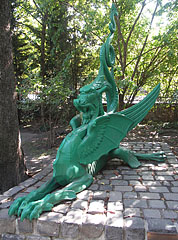 Green iron dragon
Green iron dragon
The two large cast-iron dragon statues in the Budapest Zoo are much older than they seem, and their story is quite adventurous as well.
Actually there are three of them and they were created in 1856 in the Schlick Iron Foundry by the plans of Frigyes Feszl. Initially they stood at the Pest-side end of the Széchenyi Chain Bridge, at one of the gates of the Danube Steamship Company ("Duna Gőzhajózási Társaság") close to the Danube bank. When the embankments were rebuilt they were moved to the edge of the City Park ("Városliget").
In 1958 one of the dragons was placed in front of the Kiscelli Museum in Buda, as well as the other two were moved to the recently closed Budapest Amusement Park ("Vidám Park") near the "Enchanted Castle" (in Hungarian "Elvarázsolt Kastély") attraction. Finally the two iron dragons were moved to the Budapest Zoo from that place in 2010.
After a long operation the Budapest Amusement Park or "Vidám Park" was closed in September 2013, and then the area was acquired by the Budapest Zoo. Today this area is called "Holnemvolt Park" (literally "Once Upon a Time Park"), where among other things some of the old, monumental attraction of the former theme park could get a new life.
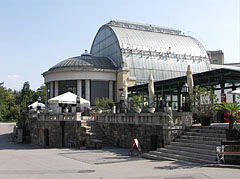 Palm House, today it is called "America Tropicana"
Palm House, today it is called "America Tropicana"
The building was designed by Gyula Végh and built between 1909-1912. There was a major renovation between 1991 and 2000.
The Palm House of the Budapest Zoo & Botanical Garden was originally designed to the Gellért Hill, but during the big reconstruction of the zoo between 1909-1912 the decision-makers changed their mind and then they decided that here shore of the Great Lake will be the best place for it. The technical design was made by Gyula Végh, as well as the horticultural (garden) design was the work of Keresztély Ilsemann and Károly Räde.
The building is an iron-structure big glass hall that consists of two main parts and 3-3 side halls. Beside presenting plants it also had a terrarium, for example in 1934 crocodiles were settled in the semicircular part what is today a confectionery.
The World War II caused serious damages in the Palm House, and it could be opened again only in 1952, but then it was still in very bad condition due to among other things the damages and the humid climate inside the building. These problems were fixed only by the big reconstructions between 1991-2000, so as of today the visitors can view this together with the Aquarium in its original (or even more beautiful) splendor again.
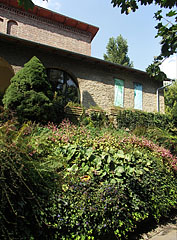 János Xántus House
János Xántus House
It was built in 1952, designed by the Municipal Planning Bureau, in Hungarian "Fővárosi Tervező Iroda".
János Xántus (1825-1894) was a Hungarian zoologist, traveler and ethnographer, and also the first director of the Budapest Zoo. Outside of Hungary he is known as John Xantus de Vesey. He supported the Hungarian National Museum by significant botanical and zoological collections.
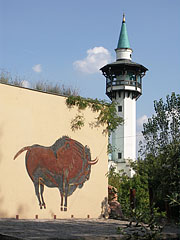 Wall painting (more precisely a sgraffito) of a bison on the wall of the Bison House that was built in 1963 and demolished in 2010
Wall painting (more precisely a sgraffito) of a bison on the wall of the Bison House that was built in 1963 and demolished in 2010
The sgraffito is not a simple mural or painting, but a picture that is created by conscious and precise scraping of the different colored coating or plaster layers, after they were deposited on the wall one after the other. This is the situation for example in the case of the Bisons' House ("Bölényház") in the zoo.
The Bison House of the Budapest Zoo & Botanical Garden was built in 1963 in socialist realist style by the plans of Gyula Kéri and Ferenc Bognár, on the site of the former Buffalo House which was built in 1912 and destroyed in the World War II. The bison figure on its wall was designed by Jenő József Percz, inspired by prehistoric cave paintings and African drawings considering both the shape and the colors. The building was demolished in 2010 and the replica of the former Buffalo House of Károly Kós and Dezső Zrumeczky architects was built on the top of its foundations. From then it is unknown what happened with the bison picture.
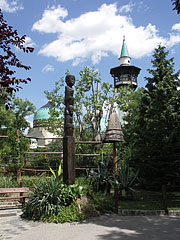 Wooden column-sculpture with African ground idols, and the Elephant House with its observation tower can be seen in the distance as well
Wooden column-sculpture with African ground idols, and the Elephant House with its observation tower can be seen in the distance as well
The originals of two wooden column-sculpture close to the so-called Elephant Gate of the Budapest Zoo were brought here to Budapest from the Congo region in Africa, and they were exhibited when the zoo was renovated in 1912. However, these sculptures were destroyed in the World War II. The columns were resculpted of wood by the Hungarian sculptor József Tóth in Tanzania, Africa, and they were placed to their current site in 1998 by courtesy of Pál Lendvai and Gyula Pázmándi.
Budapest - Fler fotogallerier:
Du kanske också är intresserad av (Relaterade sidor):
Destinationer i reseguide:
Budapest (8 468 bilder + 21 panorama bilder)
Buda Hills (Budai-hegység) (8 632 bilder + 21 panorama bilder)
Pest megye (county) (15 122 bilder + 50 panorama bilder)
Budapest och dess omgivningar (15 989 bilder + 52 panorama bilder)
Ungern (27 287 bilder + 163 panorama bilder)
och dessutom:
(inom här: Buda Hills)
Budakeszi (88 bilder)
Pilisszentiván (76 bilder)
Varje panorama foto i:
Budapest (21 bilder)
Pest megye (county) (50 bilder)
Budapest och dess omgivningar (52 bilder)
Ungern (163 bilder)
Europa (165 bilder)
Alla normal bilder i:
Budapest (8 468 bilder / 122 gallerier)
Buda Hills (Budai-hegység) (8 632 bilder / 124 gallerier)
Pest megye (county) (15 122 bilder / 221 gallerier)
Budapest och dess omgivningar (15 989 bilder / 234 gallerier)
Ungern (27 287 bilder / 462 gallerier)
Europa (30 494 bilder / 523 gallerier)
https://www.panadea.com/sv/guidebook/budapest/photos/gal-085

Lägg till i Favoriter Lägg till Bokmärke
Dela med dina vänner!
etc.
Om oss - Ansvarsfriskrivning -
Alla rättigheter reserverade
- ©2010-2022
Neuronit Creative Studio - Mogyoród / Budapest / Ungern



